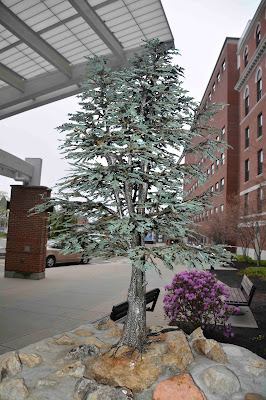 |
| Opposite our hotel |
There were mimes, tourist shops, and restaurants with sidewalk tables along La Rambla. Above the first floor restaurants and shops were residences with small balconies overlooking the streets and nearly half displayed political banners, flags, and posters draped over them calling for Catalan independence. Tourist literature called our section the “nerve center” of Barcelona — the city which is itself the nerve center of Catalonia.
We were sipping wine on our little balcony our first night there when we heard chanting in Spanish getting louder by the minute. Then demonstrators marched out of the street across from our balcony which connected La Rambla to the Gothic quarter. They carried Catalan flags and signs and chanted a phrase neither of us understood.
Last October, Catalonia tried to hold a referendum declaring independence but Spanish authorities violently disrupted the vote. According to CNN: “Police fired rubber bullets at protesters and voters trying to take part in the referendum, and used batons to beat them back using rubber bullets.” Nine hundred people were injured.
Across from our balcony was another owned by a local woman with a Catalan flag and another banner I couldn’t read. Our bellman told me she is a leader in the independence movement. Last October counter demonstrators gathered on the street below and tried to get her to come out, but she wouldn’t. “They would have killed her,” said the bellman.
As if that weren’t enough, the previous August, another kind of political violence flared up when Moroccan Muslim immigrants mowed people down along La Rambla with a rented van. Sixteen people were killed and more than a hundred wounded. Our bell man told me three people died under our balcony and a dozen more lay gravely wounded. The door man pulled out his phone to show me videos too gruesome to show on television. The night before, an imam blew himself up in another area as he tried to construct explosives with gas cylinders.
Last Saturday in the Gothic Quarter very heavy drumming filled the air of a plaza where we were eating breakfast at a sidewalk cafe. Heavy base vibrated my sternum as it bounced off the stone buildings on all four sides of the plaza but I couldn’t pinpoint its source. We paid our bill and walk up the front steps of a gothic cathedral across the square where many people milled about. Looking over their heads, we could see the drummers surrounded by people holding banners and flags. When it stopped, one man with a banner told me they were rallying to keep Spain united.
Saturday night six motorcycle police gathered there and two vans of heavily armed soldiers with automatic weapons positioned themselves below our balcony at dusk and hotel employees said that wasn’t unusual for a Saturday night. Going to our cruise ship Sunday, there were more soldiers with automatic weapons deployed at the waterfront.
 |
| Below our balcony |
 |
| Naples |
 |
| Truck Attack in Nice |
 |
| Castle Nuovo in Naples |
Europe is changing but it’s still possible to travel peacefully, for now.
Addendum:
(ANSA) – Naples, April 26 – State and Carabinieri police arrested a Gambian national in an antiterrorism operation in Naples on Thursday, sources said.
The arrest comes after investigators found evidence the suspect was planning an attack, the sources said.
Alagie Touray, 21, admitted to investigators that he had received a request to drive a car into a crowd, the sources said. The evidence against him includes a video published on Telegram in which he allegedly pledges alliance to ISIS leader Abū Bakr al-Baghdadi.
He was detained as he left a mosque in Licola, in the province of Naples. Touray landed in Messina along with over 100 other asylum-seekers in March 2017….
We were there Tuesday. Touray was arrested Thursday. The first sign one sees when arriving in Naples by sea quotes Pope Francis and pleas for no borders. Let everyone come who wants to.
Europe is committing suicide.




































